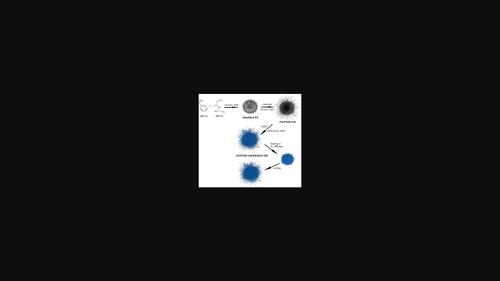当前位置:
X-MOL 学术
›
Part. Part. Syst. Charact.
›
论文详情
Our official English website, www.x-mol.net, welcomes your feedback! (Note: you will need to create a separate account there.)
Dual Stimuli-Responsive Ternary Core-Shell Polystyrene@Pnipam-Pedot Latexes
Particle & Particle Systems Characterization ( IF 2.7 ) Pub Date : 2023-10-12 , DOI: 10.1002/ppsc.202300096 Lyudmyla O. Vretik 1 , Yuriy V. Noskov 2 , Oksana M. Chepurna 3, 4 , Nikolay A. Ogurtsov 2 , Olena A. Nikolaeva 1 , Andrii I. Marynin 5 , Tymish Y. Ohulchanskyy 3 , Alexander A. Pud 2
Particle & Particle Systems Characterization ( IF 2.7 ) Pub Date : 2023-10-12 , DOI: 10.1002/ppsc.202300096 Lyudmyla O. Vretik 1 , Yuriy V. Noskov 2 , Oksana M. Chepurna 3, 4 , Nikolay A. Ogurtsov 2 , Olena A. Nikolaeva 1 , Andrii I. Marynin 5 , Tymish Y. Ohulchanskyy 3 , Alexander A. Pud 2
Affiliation

|
The ability of stimuli-responsive materials to respond to external stimuli depends on their intra- and intermolecular interactions, which, in turn, are governed by changes in the material composition. Here, the importance of these factors for new heat and light-sensitive latexes of core-shell nanoparticles is reported with the polystyrene core, the poly(N-isopropylacrylamide) (PNIPAM) shell containing doped poly(3,4-ethylenedioxythiophene) (PEDOT). It is found that hydrogen bonding, C═O─π aromatic, hydrophilic-hydrophobic interactions in the shell cause conformational changes in PNIPAM similar to those occurring in the PNIPAM coil-globule transition. Depending on the EDOT:PS@PNIPAM feed ratio and the PEDOT content in PNIPAM shells, these interactions and changes affect nanoparticle sizes and are responsible for shifting the lower critical solution temperature (LCST) of PNIPAM in the shell from 32.1 to 33.9 °C. The core-shell morphology of nanoparticles is maintained only for latexes with EDOT feed to ≈9 wt.%. At the higher EDOT content, PNIPAM shells are destroyed. Synthesized PS@PNIPAM-PEDOT latexes demonstrate temperature-dependent behavior and produce a photothermal effect under NIR irradiation, which allows for a rise of their temperature above LCST. This dual stimuli (heat and light) responsiveness suggests an important possibility for these latexes to be used for drug or diagnostic agent delivery.
中文翻译:

双刺激响应三元核壳聚苯乙烯@Pnipam-Pedot乳胶
刺激响应材料响应外部刺激的能力取决于它们的分子内和分子间相互作用,而分子内和分子间相互作用又受到材料成分变化的控制。在这里,这些因素对于核-壳纳米粒子的新型热敏和光敏乳胶的重要性进行了报道,其中聚苯乙烯核、含有掺杂聚(3,4-乙撑二氧噻吩)(PEDOT)的聚(N-异丙基丙烯酰胺)(PNIPAM)壳)。研究发现,壳层中的氢键、C=O─π芳香族、亲水-疏水相互作用引起PNIPAM的构象变化,类似于PNIPAM卷曲-球状转变中发生的构象变化。根据 EDOT:PS@PNIPAM 进料比和 PNIPAM 壳中的 PEDOT 含量,这些相互作用和变化会影响纳米颗粒尺寸,并导致壳中 PNIPAM 的下临界溶液温度 (LCST) 从 32.1 °C 变为 33.9 °C。仅当 EDOT 进料量达到 约 9 wt.% 的乳胶时,纳米颗粒的核壳形态才能保持。 EDOT 含量较高时,PNIPAM 壳被破坏。合成的 PS@PNIPAM-PEDOT 乳胶表现出温度依赖性行为,并在近红外辐射下产生光热效应,使其温度升至 LCST 以上。这种双重刺激(热和光)响应性表明这些乳胶用于药物或诊断剂输送的重要可能性。
更新日期:2023-10-12
中文翻译:

双刺激响应三元核壳聚苯乙烯@Pnipam-Pedot乳胶
刺激响应材料响应外部刺激的能力取决于它们的分子内和分子间相互作用,而分子内和分子间相互作用又受到材料成分变化的控制。在这里,这些因素对于核-壳纳米粒子的新型热敏和光敏乳胶的重要性进行了报道,其中聚苯乙烯核、含有掺杂聚(3,4-乙撑二氧噻吩)(PEDOT)的聚(N-异丙基丙烯酰胺)(PNIPAM)壳)。研究发现,壳层中的氢键、C=O─π芳香族、亲水-疏水相互作用引起PNIPAM的构象变化,类似于PNIPAM卷曲-球状转变中发生的构象变化。根据 EDOT:PS@PNIPAM 进料比和 PNIPAM 壳中的 PEDOT 含量,这些相互作用和变化会影响纳米颗粒尺寸,并导致壳中 PNIPAM 的下临界溶液温度 (LCST) 从 32.1 °C 变为 33.9 °C。仅当 EDOT 进料量达到 约 9 wt.% 的乳胶时,纳米颗粒的核壳形态才能保持。 EDOT 含量较高时,PNIPAM 壳被破坏。合成的 PS@PNIPAM-PEDOT 乳胶表现出温度依赖性行为,并在近红外辐射下产生光热效应,使其温度升至 LCST 以上。这种双重刺激(热和光)响应性表明这些乳胶用于药物或诊断剂输送的重要可能性。



























 京公网安备 11010802027423号
京公网安备 11010802027423号